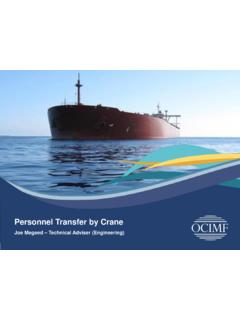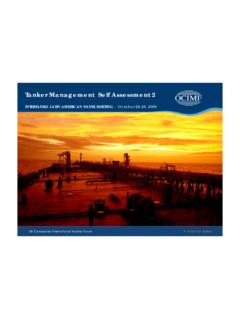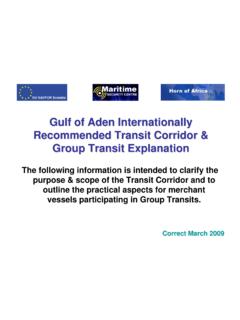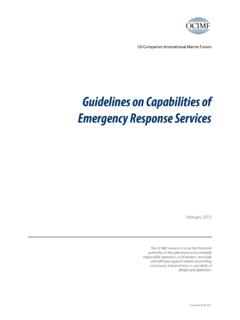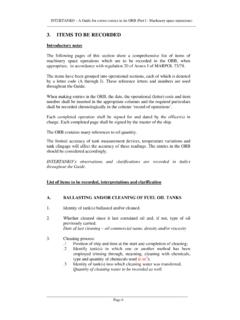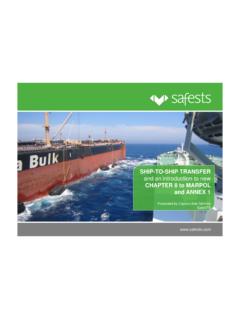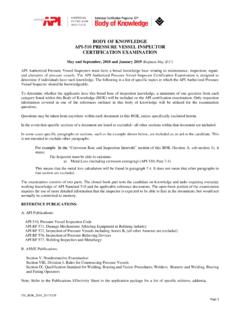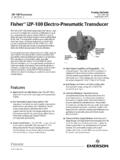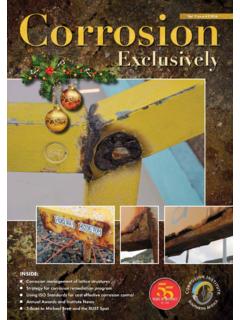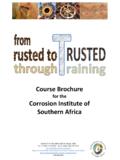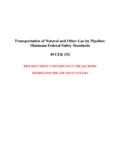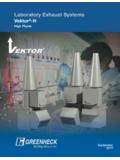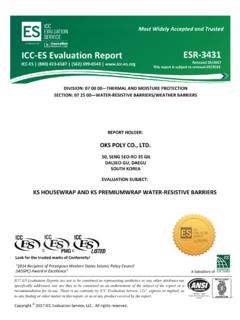Transcription of Ballast Water Management Systems: Technology …
1 Ballast Water Management Systems: Technology DevelopmentsINTERTANKO Lunchtime Seminar on BWMD ebra DiCiannaSenior Principal Environmental Solutions EngineerLondon, UK8 September 20152 TopicslBallast Water Management OptionslUSCG Type Approval ProcesslInformation on Ballast Water Management Systems (BWMS)lPractical Means For Compliance with USCG RequirementsnUSCG extensions requestsnDrydocking movementslPreparing for Compliance3 Understanding Compliance OptionslShips on Worldwide VoyagesnMonitor progress in ratifying the BWM ConventionnIdentify the IOPP Renewals SurveynMonitor changes in the revision of the G8 Guidelines for approval of BWMSlShips Dischargingin US WatersnDetermine ship ballasting requirementsnFollow USCG type approval processnIdentify Technology options4 BWMS TechnologiesBallast Water Management
2 SystemPhysical Separation* Filtration Hydrocyclone CoagulationDisinfection*Chemical DisinfectionPhysical Disinfection+ Electro-chlorination Chlorine-based Chemicals Ozone Other disinfectants UV De-oxygenation HeatorSupplementary Treatment* Cavitation Ultrasound Catalyst Plasma Magnetic Separation+*Note: BWMS have been developed using different combinations of the Pros and ConsFiltrationProslEliminates larger organisms, reduces total organisms/biomass to kill and reduces maximum sediment size allowing improved active substance effectivenesslSediment in the Ballast tanks may be reduced due to filtrationConslClogginglReliability of the mechanical componentslRestriction for piping systemlReliability for corrosionlSusceptible to Water -hammer damagelDamage by physical substances in the pipinglSpare parts for moving componentslRequired backpressure for backflow washing6 Electrochlorination Pros and ConsElectrochlorinationProslLow
3 Additional flow restrictionlMay provide residual disinfectant in Ballast tanks for protection against organism Ballast Water temperatures is low, only 1% (or less) of Ballast flow would require heating (side-stream arrangement)lEasier installation on vessels with cargo pump rooms or hazardous cargo areas (side-stream arrangement)ConslGeneration of hazardous gaseslNeed for certified safe construction of electrochlorination unit when used in tankerlLife and maintenance of electrodeslCorrosionlUse in freshwaterlStorage of neutralizing agentslNeutralization for dischargelDisinfection byproductslTime for lethality of organisms (varies by vendor)
4 7 Chemical Application Pros and ConsChemical ApplicationProslReduced complexity of installed system and CAPEXC onslActive substances increased potential for corrosionlAdditional handling and storage of hazardous chemicals -personnel (PPE) and training considerationslStorage, supply and leakage of chemicalslFire extinguishing system requirements for system safety must be consideredlNeutralization for discharge (varies by vendor)lTime for lethality of organisms (varies by vendor)lSome technologies create disinfection byproducts 8 Deoxygenation Pros and ConsDeoxygenationProslReduced Ballast tank corrosionlIncreased Ballast tank coating lifelReduced sacrificial anode consumptionlInert gas Technology is common on oil tankerslNo active substances and no chemical storage requiredlNo neutralization chemicals requiredlNo filtration used minimizes changes to ballasting operationsConslRestriction on access to Ballast Water tanks due to inertinglSome tank arrangements may make installation
5 ComplexlSignificant amount of time for lethality of organismslNeed for precise inert conditions to meet efficacy demonstrated during testinglSpecial consideration for isolation, interlocks and controls to ensure proper treatment and re-aeration during dischargelSome technologies may use LSMGO fuelfor Stripping Gas Generator and other fuels ( , HFO) are not suitable9 Ozone Treatment Pros and ConsOzone TreatmentProslMore equipment installation options for small available spaces equipment can be located separately with smaller footprintslOzone treatment is an effective disinfectant in fresh waterConslGeneration of hazardous gaseslCorrosion of coatings and piping materialslOzone generation system installation location and ozone/ oxygen leak detection must be consideredlOzone-induced corrosion of coatings and piping materials must be consideredlOzone pipe routing
6 Restrictions and sensors -materials of construction are more expensivelStainless steel ozone distribution piping costs and more difficult installation must be consideredlRelatively high power consumption compared to other technologieslNeutralization for discharge10UV Disinfection Pros and ConsUV DisinfectionProslNo active substances used in treatmentlNo neutralization chemicals requiredConslHigh replacement cost for UV lamplPossible damage by Water hammerlIngested debris can damage UV quartz sleeveslCertified safe type needed for use in tankerlUV treatment during dischargelUV disinfection may only render organisms not viable and may not kill organisms11UV DisinfectionlUVC damages DNA and stops reproductionlPoints of impact12 USCG vs.
7 BWM Convention -UV DisinfectionUSCGBWM ConventionTerminology in discharge/performance standard for organisms 10 m in minimum dimension Living organisms Viable organisms(GuidelinesG8 state viable organisms are organisms and any life stages thereof that are living )Method for Counting Organisms 50 m (zooplankton) direct counts and mobility 10 mand < 50 m (protists) combination of vital, fluorescentstains (fluorescein diacetate (FDA) and 5-chloromethylfluorescein diacetate (CMFDA) Nospecific methods are listed Part 4 provides guidelines for sample analysis and states When available, widely accepted standard methods.)
8 Should be used. 13 FDA/CMDFDA Method lSpecifically listed in Environmental Technology Verification (ETV) Protocoll Determining the viability of marine protists using a combination of vital, fluorescent stains (Steinberg et al, Mar Biol (2011) 158:1431 1) technical paper describing the method and its validationlNeed for a robust viability analysis that is applicable to a broad range of organismslHow method works:nStain penetrates cellnEsterasesconvert stains to fluorescent productsnFluorescent cells counted as alive l This approach will be used as a benchmark for validating new viability assays and techniques in the future.
9 14 Illustration of FDA/CMFDA MethodlStain sample and living organisms fluorescelThe fluorescent organisms are counted for the number of living organismsl This approach will be used as a benchmark for validating new viability assays and techniques in the future 15 General Description of Enumeration MethodlTwo part method to determine the number of living organisms in the 10-50 m size range:nAutotroph Chlorophyll-based most probable number (MPN) dilution-culture techniquenHeterotroph Absence of Chlorophyll a autofluorescencelValues from each method are summed to provide a total concentration of living organismslEstablished a standard protocol that would be required of each laboratorynDilutionsnGrowth medianMPN calculator16 development of Enumeration Methodl Enumeration or Most Probable Number (MPN)
10 Method has been developed by UV-vendors to address the need for another means to count organismslMPN method has been used for almost 40 years for assessing viability of single species cultureslMPN method procedures vary by laboratorylUSCG and EPA identified the need to develop a consistent procedure and validate methodlProposed method developed by a collaboration of UV manufacturers in consultation with the ETV Enumeration Tech PanellTimeline of events:nLate 2012/early 2013 preliminary mtgs. with USCGnJuly 2013 present testing of methodnMarch 2015 propose method submitted to ETV Tech PanelnAugust 2015 discussion of MPN calculator nTBD method validation17 Type Approved BWMSB allast Water Management SystemsNumber of SystemsAvai
